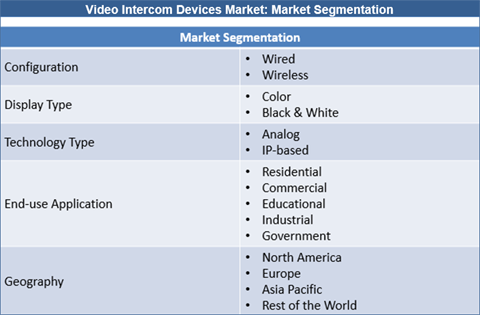According to a new market research report published by Credence Research “Video Intercom Devices Market (Configuration – Wired and Wireless; Display Type – Color and Black & White; Technology Type – Analog and IP-based; End-use Application – Residential, Commercial, Educational, Industrial and Government) – Growth, Future Prospects and Competitive Analysis, 2018 – 2026”, the global video intercom devices market was valued at US$ 16.24 Bn in 2017 and will be growing at a CAGR of 13.5% during the forecast period from 2018 to 2026.
Browse the full report at https://bit.ly/2D3s7cT
Market Insights
Video intercom devices can be defined as a stand-alone intercom system used to manage calls made at the entrance to a building. The building can be residential complex, commercial or workplace with access controlled by audiovisual communication between the inside and outside. These devices facilitates the person indoors to identify and visitor and then take decision whether to allow access to the person calling.
One of the most prominent factors aiding the video intercom devices market growth is the fact that, in recent years the concept of smart homes has gained significant popularity. Video intercom devices fits well with this concept and its demand is expected to remain high during the forecast period. Moreover, another prominent factor aiding the video intercom devices market growth is rising government initiatives towards the development of smart cities.
This factor is expected to create positive demand for these devices. Furthermore, the growth of the construction sector in Asia Pacific and the Middle East region has been substantial in recent years with numerous recently completed and upcoming residential projects.
This growth in the construction sector has created favorable demand for security systems such as video intercom devices. Growing security concerns among citizens is another important factor complimenting the video intercom devices market growth. Factors such as growing net disposable income among people especially in countries such as India, China and Brazil among others has further contributed to the market growth.
North America was the largest market for video intercom devices in 2017. The region being one of the early adopters of smart technologies has further helped the market to flourish in the region. Moreover, strong home automation industry coupled with rising spending towards security systems has contributed to the market growth in North America. People often consider these devices as a value-added service for better quality of living.
Therefore, these factors in combination expected to drive the video intercom devices market growth in the region.
Some of the major players operating in the market include Panasonic Corporation, Honeywell security, Legrand SA, Samsung, Airphone Corporation, Godrej Group, Zenitel, Zicom, Comelit Group S.P.A., Hangzhou Hikvision Digital Technology Co. Ltd. and Dahua Technologies Co. Ltd. among others.
[For a bigger picture try FREE sample of this report now!]
Table of Content:
Chapter 1 Preface
1.1 Report Description
1.1.1 Purpose of the Report
1.1.2 Target Audience
1.1.3 USP and Key Offerings
1.2 Research Scope
1.3 Market Segmentation
1.4 Research Methodology
1.4.1 Phase I – Secondary Research
1.4.2 Phase II – Primary Research
1.4.3 Phase III – Expert Panel Review
1.4.4 Assumptions
1.4.5 Approach Adopted
Chapter 2 Executive Summary
2.1 Market Snapshot: Global Video Intercom Devices Market
2.2 Global Video Intercom Devices Market, By Configuration, 2017
2.3 Global Video Intercom Devices Market, By Display Type, 2017
2.4 Global Video Intercom Devices Market, By Technology Type, 2017
2.5 Global Video Intercom Devices Market, By End-use Application, 2017
2.6 Global Video Intercom Devices Market, By Geography, 2017
Chapter 3 Market Dynamics
3.1 Market Overview
3.1.1 Global Video Intercom Devices Market Value, 2016 – 2026, (US$ Bn)
3.2 Market Drivers
3.3 Market Growth Inhibitors
3.3.1 Impact Analysis of Drivers and Restraints
3.4 Key Market Trends and Future Outlook
3.5 Attractive Investment Proposition, By Geography
3.6 Competitive Analysis
3.6.1 Market Positioning of Key Vendors
3.6.2 Key Strategies Adopted by the Leading Players

